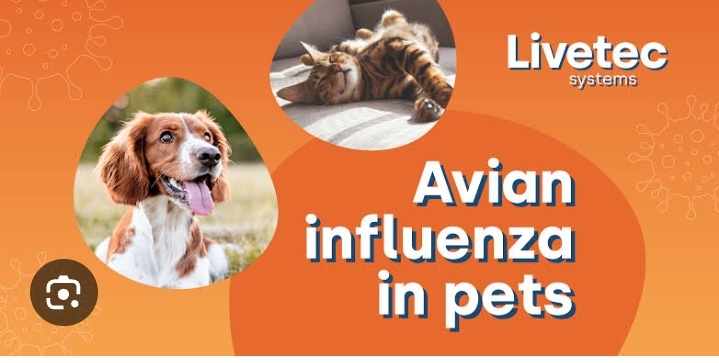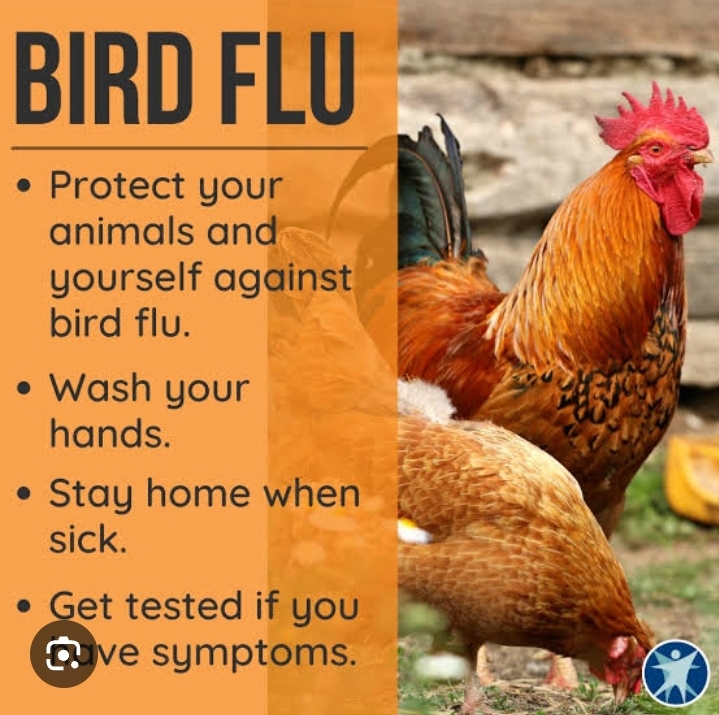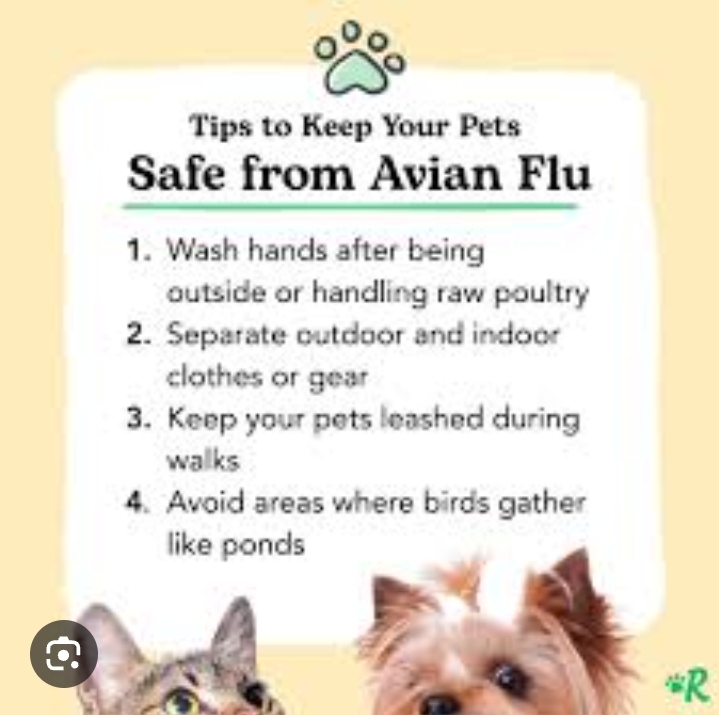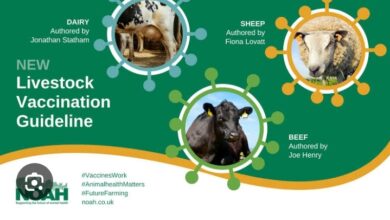Learn More In Knowing,Controlling and Preventing An influenza Fever In Domestic Animals:

Here’s an in-depth expansion on Influenza Fever in Domestic Animals, organized by species with more detailed insights into pathology, diagnostics, control measures, and public health significance:
1. Canine Influenza (Dog Flu)
Pathogenesis:
- Virus enters through the respiratory tract, attaching to epithelial cells.
- Causes inflammation of the trachea, bronchi, and lungs.
- Often leads to secondary bacterial infections, making the disease more severe.
Diagnosis in Influenza:
- PCR tests (nasal swabs) to detect viral RNA.
- Serologic testing (paired samples) to detect rising antibody levels.
- Clinical signs help guide presumptive diagnosis.
Complications:
- Pneumonia
- Chronic bronchitis in some dogs
Public Health Significance:
- Zoonotic risk is currently very low, but canine influenza is under surveillance due to its potential for mutation.

2. Feline Influenza
Additional Details:
- Feline infections are usually spillover from infected dogs or birds.
- Cats may act as intermediate hosts in some virus reassortments.
Diagnostics:
- PCR and viral isolation from respiratory secretions.
- Radiographs may show signs of pneumonia if lungs are affected.
Complications:
- Secondary bacterial infections
- In rare cases, can lead to fatal respiratory failure
Public Health Significance:
- H5N1 in cats is of concern in areas where avian flu outbreaks occur.
- Cats can act as indicators of environmental contamination by avian flu.
3. Swine Influenza (Swine Flu)m
Pathogenesis:
- Virus replicates in nasal mucosa, bronchi, and lungs.
- Causes inflammation, necrosis of the mucosa, and bronchopneumonia.
Diagnosis in Influenza:
- Nasal swabs tested by PCR or virus isolation
- Serological testing for herd-level surveillance
Economic Impact:
- Decreased weight gain
- Poor feed conversion
- Costs associated with treatment and vaccination
Zoonotic Risk:
- Significant. H1N1 pandemic in 2009 originated from a reassortant swine virus.
- Swine workers are at increased risk; PPE and hygiene are critical.

4. Equine Influenza
Pathogenesis:
- Infects ciliated epithelial cells in the upper respiratory tract
- Mucociliary clearance is compromised, allowing secondary infections
Diagnosis of influenza
- Nasopharyngeal swabs for PCR or viral culture
- Serology (e.g., hemagglutination inhibition test)
Control Measures of Influenza:
- Quarantine exposed horses for at least 2 weeks
- Restrict movement during outbreaks
- Vaccinate every 6–12 months depending on risk
Complications:
- Bronchopneumonia
- Long-term reduced athletic performance
5. Avian Influenza (Bird Flu)
Types:
- Low Pathogenic (LPAI): Mild signs, decreased egg production
- Highly Pathogenic (HPAI): Sudden death, high mortality
Pathogenesis:
- HPAI spreads systemically, affecting multiple organs
- LPAI usually remains localized to the respiratory and intestinal tracts
Diagnosis in Influenza:
- PCR and virus isolation from oropharyngeal/cloacal swabs
- Pathology: hemorrhages, edema, necrosis in multiple organs
- Rapid antigen tests for field use
Control Measures of Influenza:
- Stamping out policy (culling) in most countries
- Strict biosecurity: foot baths, disinfection, control of wild bird access
- Movement restrictions during outbreaks
- Strategic vaccination in endemic areas
Zoonotic Potential:
- Some strains, like H5N1 and H7N9, can infect humans
- High fatality rates in humans; linked to close contact with infected birds

Cross-Species Considerations
Influenza Virus Mutation and Reassortment:
- This viruses have segmented RNA genomes.
- When different influenza viruses infect the same host (especially pigs, which are “mixing vessels”), reassortment can occur.
- This can result in novel strains with pandemic potential (e.g., H1N1 in 2009).
Read More About: Mange in Animals
Surveillance Programs:
- WHO, OIE (now WOAH), and FAO run One Health surveillance programs.
- Monitoring this disease in domestic animals is critical for early detection of emerging zoonoses.
Check Here for any Available Vacancies
Influenza fever, commonly referred to as or flu, is a highly contagious viral disease that affects a wide range of animal species, including humans. It is caused by viruses belonging to the Orthomyxoviridae family and primarily classified into three types relevant to animals: fever A, B, and C. Of these, Influenza A viruses are the most significant in animals due to their ability to infect multiple species and cause pandemics.
Geographical Distribution (Where Influenza Affects Animals)
This disease is a worldwide disease, occurring across all continents and affecting both domestic and wild animals. However, its impact and prevalence vary based on the virus subtype, animal host, and region.
- Poultry (avian flu) is endemic or periodically epidemic in regions such as:
- Asia (especially Southeast Asia and China)
- Middle East
- Africa
- Parts of Europe
- South America
- Swine influenza is present in pig-rearing areas globally, including:
- North America
- Europe
- Asia
- Latin America
- Equine and canine influenza has a more limited but still global presence, especially in countries with active animal industries or pet ownership.
Animals Most Affected by Influenza
1. Birds (Avian Influenza)
Birds are the primary natural hosts for many A viruses. Wild aquatic birds (e.g., ducks, geese, swans) often carry the virus without showing symptoms. However, when certain strains, especially Highly Pathogenic Avian (HPAI) like H5N1 or H7N9, infect domestic poultry (chickens, turkeys), they can cause severe disease and high mortality.
- Symptoms in poultry include:
- Sudden death
- Respiratory distress
- Swollen head
- Reduced egg production
- Diarrhea
- HPAI outbreaks are economically devastating and lead to mass culling.
2. Pigs (Swine Influenza)
Swine are considered “mixing vessels” for this viruses because they can be infected by avian, human, and swine strains. This makes them crucial in the emergence of new virus subtypes.
- Symptoms in pigs:
- Coughing
- Nasal discharge
- Fever
- Loss of appetite
- Reduced growth rates
Swine Fever is common in pig-producing regions and can also occasionally infect humans (as seen with the 2009 H1N1 pandemic).
3. Horses (Equine Influenza)
Equine fever is widespread, particularly in countries with large horse populations. Outbreaks can halt horse racing and equestrian activities.
- Symptoms:
- High fever
- Dry cough
- Nasal discharge
- Lethargy
4. Dogs (Canine Influenza)
Canine fever is caused by adapted strains from horses (H3N8) and birds (H3N2). It’s most common in shelters or kennels.
- Symptoms:
- Coughing
- Sneezing
- Fever
- Nasal discharge
5. Humans (Zoonotic Potential)
Certain animal viruses can cross species barriers and infect humans, such as H5N1, H7N9, and H1N1. Close contact with infected animals is the main transmission route and we must always disinfect ourselves.
Conclusion
This fever is a globally distributed disease affecting a broad range of animals, especially poultry, pigs, horses, dogs, and wild birds. Regions with intensive farming and close animal-human contact are at the highest risk. Surveillance, vaccination, and biosecurity are key to controlling the disease in animals and preventing zoonotic transmission to humans.




